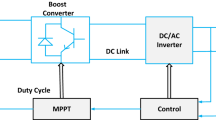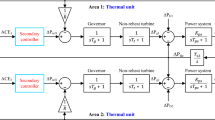Abstract
In this study, a nature-inspired optimization tool called the water cycle algorithm (WCA) and its practical application to efficiently design a cascade controller for two area interconnected power system model is put forward to address the issues in load frequency control (LFC). The cascade control (CC) structure is one of the most effective controllers for improving the performance of a control scheme in power applications, particularly when disturbances occur. In this paper, a well-systematized combination of the WCA and a well-designed cascade tilt-derivative tilt-integral (TD-TI) cascade controller is introduced, and an error performance function, for example, the integral time absolute error, is taken. The proposed WCA-based effective TD-TI, TID, and PID strategy are executed as one broadly two area multi-source model with/without HVDC link under many scenarios to verify the effectiveness of the proposed system under a high-load perturbation and some critical parameters associated with the interconnected power system. Simulation results reveal that the proposed technique provides superior performance to that of newly published schemes such as many objective/PID, TLBO/PID, IPA/TID and IGWO/Fuzzy-PID controllers. The dynamic investigation is also completed with consideration of the random load pattern, which sufficiently reveals the superior performance of the WCA/TD-TI scheme.












Similar content being viewed by others

Abbreviations
- i :
-
Subscript associated \({\text{to area}}\) \(\left( {i = 1, 2} \right)\)
- f :
-
Nominal frequency \(\left( {{\text{Hz}}} \right)\)
- P R :
-
Area \({\text{rated}}\) power \(\left( {{\text{MW}}} \right)\)
- P L :
-
Nominal operative load \(\left( {{\text{MW}}} \right)\)
- ∆f i :
-
Frequency deviations \(\left( {{\text{Hz}}} \right)\)
- ∆P Li :
-
Step load change
- ∆P tie :
-
Tie \({\text{ - line deviation}}\) of power \(\left( {{\text{p}}.{\text{u}}.} \right)\)
- B i :
-
Frequency bias \(\left( {{\text{p}}.{\text{u}}.{\text{MW}}/{\text{Hz}}} \right)\)
- R i :
-
Speed regulation \(({\text{Hz}}/{\text{p}}.{\text{u}}.\))
- T ti :
-
Steam turbine \({\text{time constant}}\) \(\left( {\text{s}} \right)\)
- T gi :
-
Speed governor time constant \(\left( {\text{s}} \right)\)
- T 12 :
-
Synchronizing coefficient \(\left( {{\text{p}}.{\text{u}}.} \right)\)
- T RSi :
-
Hydro \({\text{turbine speed governor}}\) reset time \(\left( {\text{s}} \right)\)
- T GHi :
-
Hydro \({\text{turbine speed governor}}\) time constant \(\left( {\text{s}} \right)\)
- T RHi :
-
\({\text{Hydro turbine speed governor transient}} {\text{droop}}\) Time constant (s)
- T Wi :
-
Nominal initial \({\text{time of water in penstock}}\left( {\text{s}} \right)\)
- K Ri :
-
\({\text{Reheat coefficient of steam turbine}}\)
- T ri :
-
\({\text{Reheat time constant of steam turbine }}\left( {\text{s}} \right)\)
- K pSi :
-
\({\text{Power system gain }}\left( {{\text{Hz}}/{\text{p}}.{\text{u}}.} \right)\)
- T pSi :
-
\({\text{Power system time constant }}\left( {\text{s}} \right)\)
- K T :
-
Contribution factors of thermal unit
- K H :
-
Contribution \({\text{factors of}}\) hydro unit
- K G :
-
\({\text{Contribution factors of gas unit}}\)
- K DC :
-
\({\text{HVDC gain of power system }}\left( {{\text{Hz}}/{\text{p}}.{\text{u}}.} \right)\)
- T DC :
-
HVDC time constant \(\left( {\text{s}} \right)\)
- b g :
-
Gas turbine constant of positioner \(\left( {\text{s}} \right)\)
- c g :
-
Gas turbine valve positioner
- Y C :
-
\({\text{Lag time of gas turbine governor }}\left( {\text{s}} \right)\)
- X C :
-
Lead \({\text{time of gas turbine}}\) \({\text{governor }}\left( {\text{s}} \right)\)
- T fi :
-
Gas \({\text{turbine fuel time}}\) constant \(\left( {\text{s}} \right)\)
- T CDi :
-
\({\text{Gas turbine compressor discharge volume\; time constant (s)}}\)
- TCRi :
-
Gas \({\text{turbine combustion reaction}}\;{\text{time delay }}\left( {\text{s}} \right)\)
References
Abdel-Magid YL, Dawoud MM (1995) Genetic algorithms applications in load frequency control
Alhelou HH, Hamedani-Golshan M-E, Zamani R, Heydarian-Forushani E, Siano P (2018) Challenges and opportunities of load frequency control in conventional, modern and future smart power systems: a comprehensive review. Energies 11(10):2497
Ali ES, Abd-Elazim SM (2013) BFOA based design of PID controller for two area load frequency control with nonlinearities. Int J Electr Power Energy Syst 51:224–231
Barisal AK (2015) Comparative performance analysis of teaching learning based optimization for automatic load frequency control of multi-source power systems. Int J Electr Power Energy Syst 66:67–77
Behera A, Panigrahi TK, Ray PK, Sahoo AK (2019) A novel cascaded PID controller for automatic generation control analysis with renewable sources. IEEE/CAA J Autom Sin 6(6):1438–1451
Bevrani H (2014) Robust power system frequency control
Chatterjee K (2011) Design of dual mode PI controller for load frequency control. Int J Emerg Electr Power Syst 11(4)
Crowe J et al (2005) PID control: new identification and design methods. Springer, Berlin
Daneshfar F, Bevrani H, Mansoori F (2011) Bayesian networks design of load-frequency control based on GA. In: The 2nd International Conference on Control, Instrumentation and Automation, 2011, pp 315–319
Dash P, Saikia LC, Sinha N (2015) Automatic generation control of multi area thermal system using Bat algorithm optimized PD-PID cascade controller. Int J Electr Power Energy Syst 68:364–372. https://doi.org/10.1016/j.ijepes.2014.12.063
Elgerd OI (1982) Electric energy systems theory: an introduction
El-Hameed MA, El-Fergany AA (2016) Water cycle algorithm-based load frequency controller for interconnected power systems comprising non-linearity. IET Gener Transm Distrib 10(15):3950–3961
Eskandar H, Sadollah A, Bahreininejad A, Hamdi M (2012) Water cycle algorithm—a novel metaheuristic optimization method for solving constrained engineering optimization problems. Comput Struct 110:151–166
Fini MH, Yousefi GR, Alhelou HH (2016) Comparative study on the performance of many-objective and single-objective optimisation algorithms in tuning load frequency controllers of multi-area power systems. IET Gener Transm Distrib 10(12):2915–2923
Franks RG, Worley CW (1956) Quantitative analysis of cascade control. Ind Eng Chem 48(6):1074–1079
Gautam SK, Goyal N (2010) Improved particle swarm optimization based load frequency control in a single area power system. In: 2010 Annual IEEE India Conference (INDICON), 2010, pp 1–4
Guha D, Roy PK, Banerjee S (2018) Maiden application of SSA-optimised CC-TID controller for load frequency control of power systems. IET Gener Transm Distrib 13(7):1110–1120
Hosseini SH, Etemadi AH (2008) Adaptive neuro-fuzzy inference system based automatic generation control. Electr Power Syst Res 78(7):1230–1239
Jain T, Nigam MJ (2008) Optimization of PD-PI controller using swarm intelligence. Int J Comput Cogn 6(4):55–59
Jeng J-C, Liao S-J (2013) A simultaneous tuning method for cascade control systems based on direct use of plant data. Ind Eng Chem Res 52(47):16820–16831
Johnson MA, Moradi MH (2005) PID control. Springer, Berlin
Kumari S, Shankar G (2018) Novel application of integral-tilt-derivative controller for performance evaluation of load frequency control of interconnected power system. IET Gener Transm Distrib 12(14):3550–3560
Kumari S, Shankar G (2019) Maiden application of cascade tilt-integral–tilt-derivative controller for performance analysis of load frequency control of interconnected multi-source power system. IET Gener Transm Distrib 13(23):5326–5338
Kundur P, Balu NJ, Lauby MG (1994) Power system stability and control, vol 7. McGraw-hill, New York
Lee KA, Yee H, Teo CY (1991) Self-tuning algorithm for automatic generation control in an interconnected power system. Electr Power Syst Res 20(2):157–165
Lee Y, Park S, Lee M (1998) PID controller tuning to obtain desired closed loop responses for cascade control systems. Ind Eng Chem Res 37(5):1859–1865
Magdy G, Mohamed EA, Shabib G, Elbaset AA, Mitani Y (2018) SMES based a new PID controller for frequency stability of a real hybrid power system considering high wind power penetration. IET Renew Power Gener 12(11):1304–1313
Mohanty P, Sahu RK (2019) Differential evolution optimized cascade tilt-integral-tilt-integral-derivative controller for frequency regulation of interconnected power system. In: International Conference on Application of Robotics in Industry using Advanced Mechanisms, 2019, pp 104–111
Mohanty B, Panda S, Hota PK (2014) Controller parameters tuning of differential evolution algorithm and its application to load frequency control of multi-source power system. Int J Electr power energy Syst 54:77–85
Sadollah A, Eskandar H, Lee HM, Yoo DG, Kim JH (2016) Water cycle algorithm: a detailed standard code. SoftwareX 5:37–43
Sahoo BP, Panda S (2018) Improved grey wolf optimization technique for fuzzy aided PID controller design for power system frequency control. Sustain Energy Grids Networks 16:278–299
Sahu RK, Gorripotu TS, Panda S (2015) A hybrid DE–PS algorithm for load frequency control under deregulated power system with UPFC and RFB. Ain Shams Eng J 6(3):893–911
Sahu RK, Panda S, Rout UK, Sahoo DK (2016a) Teaching learning based optimization algorithm for automatic generation control of power system using 2-DOF PID controller. Int J Electr Power Energy Syst 77:287–301
Sahu RK, Panda S, Biswal A, Sekhar GTC (2016b) Design and analysis of tilt integral derivative controller with filter for load frequency control of multi-area interconnected power systems. ISA Trans 61:251–264
Shayeghi H, Shayanfar HA, Jalili A (2009) LFC design of a deregulated power system with TCPS using PSO. Int J Electr Electron Eng 3(10):632–640
Shoults RR, Ibarra JAJ (1993) Multi-area adaptive LFC developed for a comprehensive AGC simulator. IEEE Trans Power Syst 8(2):541–547
Simhadri KS, Mohanty B, Panda SK (2019) Comparative performance analysis of 2DOF state feedback controller for automatic generation control using whale optimization algorithm. Optim Control Appl Methods 40(1):24–42
Talaq J, Al-Basri F (1999) Adaptive fuzzy gain scheduling for load frequency control. IEEE Trans Power Syst 14(1):145–150
Tan W (2009) Unified tuning of PID load frequency controller for power systems via IMC. IEEE Trans Power Syst 25(1):341–350
Topno PN, Chanana S (2018) Load frequency control of a two-area multi-source power system using a tilt integral derivative controller. J Vib Control 24(1):110–125
Vrdoljak K, Perić N, Šepac D (2010) Optimal distribution of load-frequency control signal to hydro power plants. In: 2010 IEEE International Symposium on Industrial Electronics, 2010, pp 286–291
Yousef H (2015) Adaptive fuzzy logic load frequency control of multi-area power system. Int J Electr Power Energy Syst 68:384–395
Funding
This research received no specific grant from any funding agency in the public, commercial, or not-for-profit sectors.
Author information
Authors and Affiliations
Corresponding author
Ethics declarations
Conflict of interest
The authors declare no conflict of interest in preparing this article.
Additional information
Publisher's Note
Springer Nature remains neutral with regard to jurisdictional claims in published maps and institutional affiliations.
Appendix A (Mohanty et al. 2014)
Appendix A (Mohanty et al. 2014)
\({\text{P}}_{{{\text{rt}}}} = 2000{\text{ MW}};\;{\text{P}}_{{\text{L}}} = 1840{\text{ MW}}; \;B_{1} = B_{2} = 0.4312 \;{\text{p}}.{\text{u}}.{\text{ MW}}/{\text{H}}_{{\text{Z}}}\); \(R_{1} = R_{2} = R_{3} = 2.4{\text{ H}}_{Z} /{\text{p}}.{\text{u}}.\); \(T_{sg1} = T_{sg2} = 0.08{\text{ s}}\);
\(T_{t1} = T_{t2} = 0.3 s\); \(K_{r1} = K_{r2} = 0.3; \) \(T_{r1} = T_{r2} = 10 s; \) \(K_{PS1} = K_{PS2} = 68.9566{\text{ H}}_{Z} /{\text{p}}.{\text{u}}\); \(T_{PS1} = T_{PS2} = 11.49 {\text{ s}}\);
\(T_{12} = 0.0433 {\text{p}}.{\text{u}}.;{ }a_{12} = - 1; \) \(T_{w1} = T_{w2} = 1{\text{ s}}; \) \(T_{RS1} = T_{RS2} = 5 {\text{ s}}\); \(T_{RH1} = T_{RH2} = 78.75 {\text{ s}}\); \(T_{GH1} = T_{GH2} = 0.2 {\text{ s}}\); \(X_{C} = 0.6 s\); \(Y_{C} = 1 {\text{s}};\) \(c_{g} = 1 s;\) \(b_{g} = 0.05 s;\) \(T_{F1} = T_{F2} = 0.23 {\text{s}}\); \(T_{CD1} = T_{CD2} = 0.2 {\text{s}}\); \(T_{CR1} = T_{CR2} = 0.01 {\text{s}}\);
\(K_{T} = 0.543478\); \(K_{H} = 0.326084\); \(K_{G} = 0.130438\); \(K_{DC} = 1\); \(T_{DC} = 0.2 s\);
Rights and permissions
About this article
Cite this article
Barakat, M., Donkol, A., Hamed, H.F.A. et al. Controller parameters tuning of water cycle algorithm and its application to load frequency control of multi-area power systems using TD-TI cascade control. Evolving Systems 13, 117–132 (2022). https://doi.org/10.1007/s12530-020-09363-0
Received:
Accepted:
Published:
Issue Date:
DOI: https://doi.org/10.1007/s12530-020-09363-0



